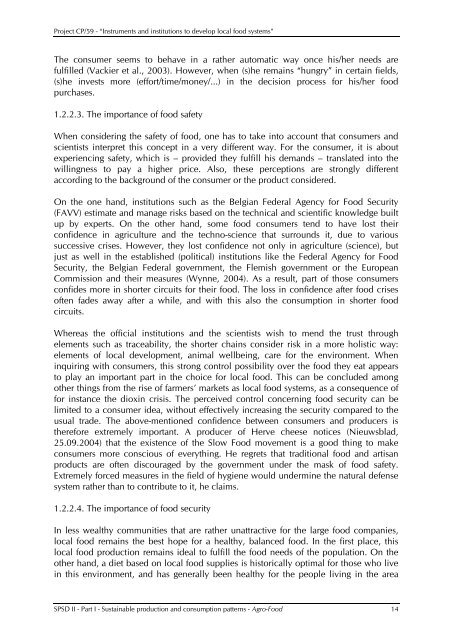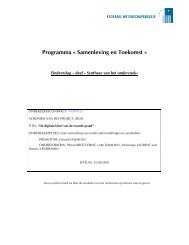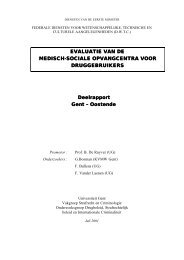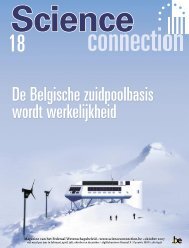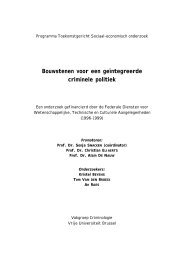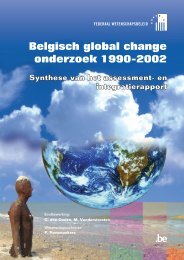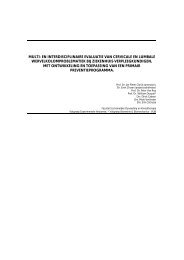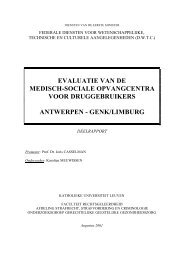chapter 3 inventory of local food systems
chapter 3 inventory of local food systems
chapter 3 inventory of local food systems
You also want an ePaper? Increase the reach of your titles
YUMPU automatically turns print PDFs into web optimized ePapers that Google loves.
Project CP/59 - “Instruments and institutions to develop <strong>local</strong> <strong>food</strong> <strong>systems</strong>”<br />
The consumer seems to behave in a rather automatic way once his/her needs are<br />
fulfilled (Vackier et al., 2003). However, when (s)he remains “hungry” in certain fields,<br />
(s)he invests more (effort/time/money/...) in the decision process for his/her <strong>food</strong><br />
purchases.<br />
1.2.2.3. The importance <strong>of</strong> <strong>food</strong> safety<br />
When considering the safety <strong>of</strong> <strong>food</strong>, one has to take into account that consumers and<br />
scientists interpret this concept in a very different way. For the consumer, it is about<br />
experiencing safety, which is – provided they fulfill his demands – translated into the<br />
willingness to pay a higher price. Also, these perceptions are strongly different<br />
according to the background <strong>of</strong> the consumer or the product considered.<br />
On the one hand, institutions such as the Belgian Federal Agency for Food Security<br />
(FAVV) estimate and manage risks based on the technical and scientific knowledge built<br />
up by experts. On the other hand, some <strong>food</strong> consumers tend to have lost their<br />
confidence in agriculture and the techno-science that surrounds it, due to various<br />
successive crises. However, they lost confidence not only in agriculture (science), but<br />
just as well in the established (political) institutions like the Federal Agency for Food<br />
Security, the Belgian Federal government, the Flemish government or the European<br />
Commission and their measures (Wynne, 2004). As a result, part <strong>of</strong> those consumers<br />
confides more in shorter circuits for their <strong>food</strong>. The loss in confidence after <strong>food</strong> crises<br />
<strong>of</strong>ten fades away after a while, and with this also the consumption in shorter <strong>food</strong><br />
circuits.<br />
Whereas the <strong>of</strong>ficial institutions and the scientists wish to mend the trust through<br />
elements such as traceability, the shorter chains consider risk in a more holistic way:<br />
elements <strong>of</strong> <strong>local</strong> development, animal wellbeing, care for the environment. When<br />
inquiring with consumers, this strong control possibility over the <strong>food</strong> they eat appears<br />
to play an important part in the choice for <strong>local</strong> <strong>food</strong>. This can be concluded among<br />
other things from the rise <strong>of</strong> farmers’ markets as <strong>local</strong> <strong>food</strong> <strong>systems</strong>, as a consequence <strong>of</strong><br />
for instance the dioxin crisis. The perceived control concerning <strong>food</strong> security can be<br />
limited to a consumer idea, without effectively increasing the security compared to the<br />
usual trade. The above-mentioned confidence between consumers and producers is<br />
therefore extremely important. A producer <strong>of</strong> Herve cheese notices (Nieuwsblad,<br />
25.09.2004) that the existence <strong>of</strong> the Slow Food movement is a good thing to make<br />
consumers more conscious <strong>of</strong> everything. He regrets that traditional <strong>food</strong> and artisan<br />
products are <strong>of</strong>ten discouraged by the government under the mask <strong>of</strong> <strong>food</strong> safety.<br />
Extremely forced measures in the field <strong>of</strong> hygiene would undermine the natural defense<br />
system rather than to contribute to it, he claims.<br />
1.2.2.4. The importance <strong>of</strong> <strong>food</strong> security<br />
In less wealthy communities that are rather unattractive for the large <strong>food</strong> companies,<br />
<strong>local</strong> <strong>food</strong> remains the best hope for a healthy, balanced <strong>food</strong>. In the first place, this<br />
<strong>local</strong> <strong>food</strong> production remains ideal to fulfill the <strong>food</strong> needs <strong>of</strong> the population. On the<br />
other hand, a diet based on <strong>local</strong> <strong>food</strong> supplies is historically optimal for those who live<br />
in this environment, and has generally been healthy for the people living in the area<br />
SPSD II - Part I - Sustainable production and consumption patterns - Agro-Food 14


